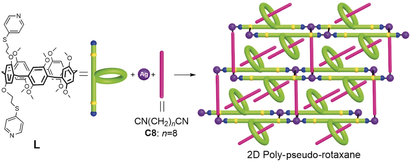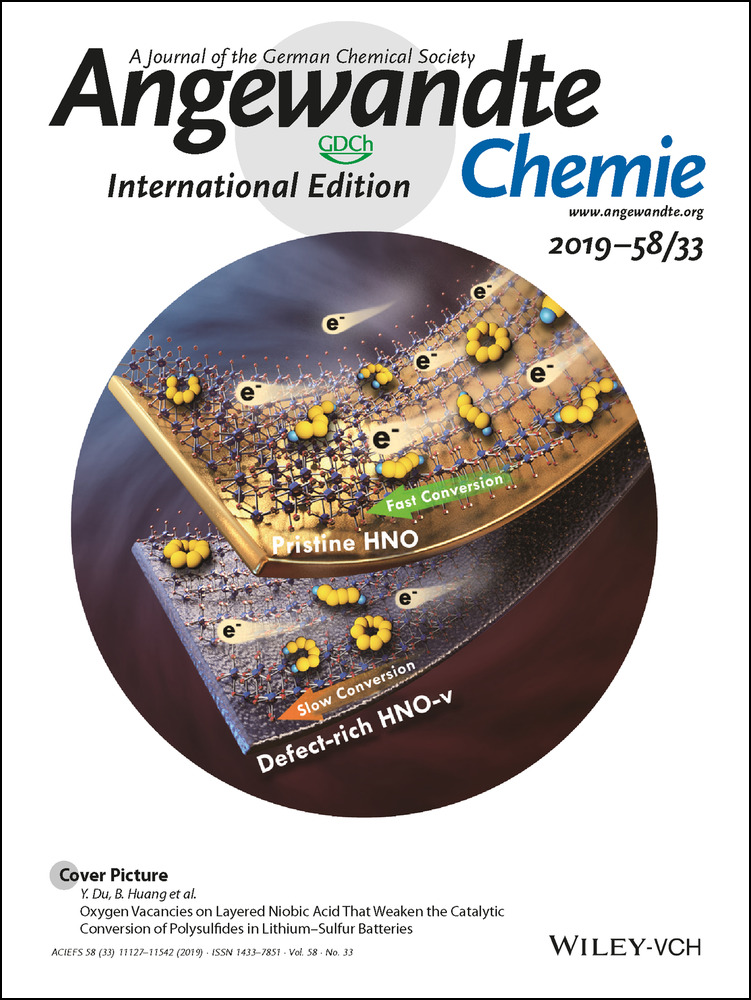Formation of a Pillar[5]arene-Based Two-Dimensional Poly-Pseudo-Rotaxane: Threading and Crosslinking by the Same Guest Molecules
Dr. Eunji Lee
Department of Chemistry and Research Institute of Natural Science, Gyeongsang National University, Jinju, 52828 South Korea
Search for more papers by this authorDr. In-Hyeok Park
Department of Chemistry and Research Institute of Natural Science, Gyeongsang National University, Jinju, 52828 South Korea
Search for more papers by this authorHuiyeong Ju
Department of Chemistry and Research Institute of Natural Science, Gyeongsang National University, Jinju, 52828 South Korea
Search for more papers by this authorSeulgi Kim
Department of Chemistry and Research Institute of Natural Science, Gyeongsang National University, Jinju, 52828 South Korea
Search for more papers by this authorProf. Jong Hwa Jung
Department of Chemistry and Research Institute of Natural Science, Gyeongsang National University, Jinju, 52828 South Korea
Search for more papers by this authorProf. Yoichi Habata
Department of Chemistry, Toho University, 2-2-1 Miyama, Funabashi, Chiba, 274-8510 Japan
Search for more papers by this authorCorresponding Author
Prof. Shim Sung Lee
Department of Chemistry and Research Institute of Natural Science, Gyeongsang National University, Jinju, 52828 South Korea
Search for more papers by this authorDr. Eunji Lee
Department of Chemistry and Research Institute of Natural Science, Gyeongsang National University, Jinju, 52828 South Korea
Search for more papers by this authorDr. In-Hyeok Park
Department of Chemistry and Research Institute of Natural Science, Gyeongsang National University, Jinju, 52828 South Korea
Search for more papers by this authorHuiyeong Ju
Department of Chemistry and Research Institute of Natural Science, Gyeongsang National University, Jinju, 52828 South Korea
Search for more papers by this authorSeulgi Kim
Department of Chemistry and Research Institute of Natural Science, Gyeongsang National University, Jinju, 52828 South Korea
Search for more papers by this authorProf. Jong Hwa Jung
Department of Chemistry and Research Institute of Natural Science, Gyeongsang National University, Jinju, 52828 South Korea
Search for more papers by this authorProf. Yoichi Habata
Department of Chemistry, Toho University, 2-2-1 Miyama, Funabashi, Chiba, 274-8510 Japan
Search for more papers by this authorCorresponding Author
Prof. Shim Sung Lee
Department of Chemistry and Research Institute of Natural Science, Gyeongsang National University, Jinju, 52828 South Korea
Search for more papers by this authorGraphical Abstract
Common thread: A two-dimensional poly-pseudo-rotaxane is reported wherein the guest molecule (C8) serves to thread the pillar[5]arene (L) units as well as crosslink one-dimensional coordinative polymeric arrays. The combination of L and C8 with silver(I) ion affords the first example of a two-dimensional poly-pseudo-rotaxane.
Abstract
A one-pot reaction of the A1/A2-thiopyridyl pillar[5]arene L with silver(I) trifluoroacetate in the presence of the linear dinitrile guest C8, [CN(CH2)nCN, n=8], afforded the first example of a two-dimensional (2D) poly-pseudo-rotaxane {[(μ4-Ag)2(C8@L)2(μ-C8)](CF3CO2)2}n. Surprisingly, in this structure the C8 guest not only threads into the pillar[5]arene unit but also crosslinks the 1D coordinative polymeric arrays. The formation of the 2D poly-pseudo-rotaxane is driven by an adaptive rearrangement of the components that minimizes the steric clashes not only between the threaded guests but also between the threaded and crosslinked guests where crosslinking occurs. A pathway for the formation of the 2D poly-pseudo-rotaxane is proposed.
Supporting Information
As a service to our authors and readers, this journal provides supporting information supplied by the authors. Such materials are peer reviewed and may be re-organized for online delivery, but are not copy-edited or typeset. Technical support issues arising from supporting information (other than missing files) should be addressed to the authors.
| Filename | Description |
|---|---|
| anie201904183-sup-0001-misc_information.pdf906.5 KB | Supplementary |
Please note: The publisher is not responsible for the content or functionality of any supporting information supplied by the authors. Any queries (other than missing content) should be directed to the corresponding author for the article.
References
- 1
- 1aV. Balzani, A. Credi, F. M. Raymo, J. F. Stoddart, Angew. Chem. Int. Ed. 2000, 39, 3348–3391;
10.1002/1521-3773(20001002)39:19<3348::AID-ANIE3348>3.0.CO;2-X CAS PubMed Web of Science® Google ScholarAngew. Chem. 2000, 112, 3484–3530;
- 1bD. B. Amabilino, J. F. Stoddart, Chem. Rev. 1995, 95, 2725–2828;
- 1cJ.-P. Sauvage, Acc. Chem. Res. 1998, 31, 611–619;
- 1dC. J. Bruns, J. F. Stoddart, Acc. Chem. Res. 2014, 47, 2186–2199;
- 1eB. Champin, P. Mobian, J.-P. Sauvage, Chem. Soc. Rev. 2007, 36, 358–366;
- 1fJ. D. Crowley, S. M. Goldup, A. L. Lee, D. A. Leigh, R. T. McBurney, Chem. Soc. Rev. 2009, 38, 1530–1541;
- 1gV. Aucagne, J. Berna, J. D. Crowley, S. M. Goldup, K. D. Haenni, D. A. Leigh, P. J. Lusby, V. E. Ronaldson, A. M. Z. Slawin, A. Viterisi, D. B. Walker, J. Am. Chem. Soc. 2007, 129, 11950–11963;
- 1hA.-J. Avestro, D. M. Gardner, N. A. Vermeulen, E. A. Wilson, S. T. Schneebeli, A. C. Whalley, M. E. Belowich, R. Carmieli, M. R. Wasielewski, J. F. Stoddart, Angew. Chem. Int. Ed. 2014, 53, 4442–4449; Angew. Chem. 2014, 126, 4531–4538;
- 1iF. Vögtle, T. Duennwald, T. Schmidt, Acc. Chem. Res. 1996, 29, 451–460;
- 1jX. Ma, H. Tian, Chem. Soc. Rev. 2010, 39, 70–80.
- 2
- 2aA. S. Lane, D. A. Leigh, A. Murphy, J. Am. Chem. Soc. 1997, 119, 11092–11093;
- 2bD. A. Leigh, A. Murphy, J. P. Smart, A. M. Z. Slawin, Angew. Chem. Int. Ed. Engl. 1997, 36, 728–732; Angew. Chem. 1997, 109, 752–756;
- 2cB. Lewandowski, G. D. Bo, J. W. Ward, M. Papmeyer, S. Kuschel, M. J. Aldegunde, P. M. E. Gramlich, D. Heckmann, S. M. Goldup, D. M. D′Souza, A. E. Fernandes, D. A. Leigh, Science 2013, 339, 189–193.
- 3
- 3aA. Harada, Acc. Chem. Res. 2001, 34, 456–464;
- 3bD.-H. Qu, Q.-C. Wang, H. Tian, Angew. Chem. Int. Ed. 2005, 44, 5296–5299; Angew. Chem. 2005, 117, 5430–5433;
- 3cS. A. Nepogodiev, J. F. Stoddart, Chem. Rev. 1998, 98, 1959–1976;
- 3dK. Kim, Chem. Soc. Rev. 2002, 31, 96–107;
- 3eA. Arduini, R. Ferdani, A. Pochini, A. Secchi, F. Ugozzoli, Angew. Chem. Int. Ed. 2000, 39, 3453–3456;
10.1002/1521-3773(20001002)39:19<3453::AID-ANIE3453>3.0.CO;2-I CAS PubMed Web of Science® Google ScholarAngew. Chem. 2000, 112, 3595–3598;
- 3fS. Kanamathareddy, C. D. Gutsche, J. Am. Chem. Soc. 1993, 115, 6572–6579;
- 3gS. J. Loeb, J. A. Wisner, Angew. Chem. Int. Ed. 1998, 37, 2838–2840;
10.1002/(SICI)1521-3773(19981102)37:20<2838::AID-ANIE2838>3.0.CO;2-E CAS PubMed Web of Science® Google ScholarAngew. Chem. 1998, 110, 3010–3013;10.1002/(SICI)1521-3757(19981016)110:20<3010::AID-ANGE3010>3.0.CO;2-Q Web of Science® Google Scholar
- 3hI.-H. Park, R. Medishetty, J.-Y. Kim, S. S. Lee, J. J. Vittal, Angew. Chem. Int. Ed. 2014, 53, 5591–5595; Angew. Chem. 2014, 126, 5697–5701;
- 3iA. Coskun, M. Hmadeh, G. Barin, F. Gndara, Q. Li, E. Choi, N. L. Strutt, D. B. Cordes, A. M. Z. Slawin, J. F. Stoddart, J.-P. Sauvage, O. M. Yaghi, Angew. Chem. Int. Ed. 2012, 51, 2160–2163; Angew. Chem. 2012, 124, 2202–2205.
- 4
- 4aE. Lee, J. Heo, K. Kim, Angew. Chem. Int. Ed. 2000, 39, 2699–2701;
10.1002/1521-3773(20000804)39:15<2699::AID-ANIE2699>3.0.CO;2-Z CAS PubMed Web of Science® Google ScholarAngew. Chem. 2000, 112, 2811–2813;
- 4bA. Harada, A. Hashidzume, H. Yamaguchi, Y. Takashima, Chem. Rev. 2009, 109, 5974–6023;
- 4cA. Harada, Y. Takashima, H. Yamaguchi, Chem. Soc. Rev. 2009, 38, 875–882;
- 4dB. F. Hoskins, R. Robson, D. A. Slizys, J. Am. Chem. Soc. 1997, 119, 2952–2953;
- 4eB. M. Rambo, H.-Y. Gong, M. Oh, J. L. Sessler, Acc. Chem. Res. 2012, 45, 1390–1401;
- 4fF. Huang, H. W. Gibson, Prog. Polym. Sci. 2002, 43, 611–612.
- 5
- 5aS.-L. Li, T. Xiao, B. Hu, Y. Zhang, F. Zhao, Y. Ji, Y. Yu, C. Lin, L. Wang, Chem. Commun. 2011, 47, 10755–10757;
- 5bC. Gong, H. W. Gibson, Curr. Opin. Solid State Mater. Sci. 1997, 2, 647–652;
- 5cM. P. L. Werts, M. Van den Boogaard, G. M. Tsivgoulis, G. Hadziioannou, Macromolecules 2003, 36, 7004–7013;
- 5dJ. Terao, S. Tsuda, Y. Tanaka, K. Okoshi, T. Fujihara, Y. Tsuji, N. Kambe, J. Am. Chem. Soc. 2009, 131, 16004–16005.
- 6H. Ju, J. K. Clegg, K.-M. Park, L. F. Lindoy, S. S. Lee, J. Am. Chem. Soc. 2015, 137, 9535–9538.
- 7T. Ogoshi, S. Kanai, S. Fujinami, T.-a. Yamagishi, Y. Nakamoto, J. Am. Chem. Soc. 2008, 130, 5022–5023.
- 8
- 8aT. Ogoshi, Pillararenes, The Royal Society of Chemistry, Cambridge, 2016;
- 8bT. Ogoshi, T.-a. Yamagishi, Y. Nakamoto, Chem. Rev. 2016, 116, 7937–8002;
- 8cM. Xue, Y. Yang, X. Chi, Z. Zhang, F. Huang, Acc. Chem. Res. 2012, 45, 1294–1308;
- 8dN. L. Strutt, D. Fairen-Jimenez, J. Iehl, M. B. Lalonde, R. Q. Snurr, O. K. Farha, J. T. Hupp, J. F. Stoddart, J. Am. Chem. Soc. 2011, 133, 5668–5671;
- 8eX. Chi, G. Yu, L. Shao, J. Chen, F. Huang, J. Am. Chem. Soc. 2016, 138, 3168–3174;
- 8fT. Ogoshi, Y. Nishida, T.-a. Yamagishi, Y. Nakamoto, Macromolecules 2010, 43, 3145–3147;
- 8gD. Xia, L. Wang, X. Lv, J. Chao, X. Wei, P. Wang, Macromolecules 2018, 51, 2716–2722.
- 9X.-Y. Hu, X. Wu, S. Wang, D. Chen, W. Xia, C. Lin, Y. Pan, L. Wang, Polym. Chem. 2013, 4, 4292–4297.
- 10
- 10aN. L. Strutt, D. Fairen-Jimenez, J. Iehl, M. B. Lalonde, R. Q. Snurr, O. K. Farha, J. T. Hupp, J. F. Stoddart, J. Am. Chem. Soc. 2012, 134, 17436–17439;
- 10bN. L. Strutt, H. Zhang, J. F. Stoddart, Chem. Commun. 2014, 50, 7455–7458.
- 11E. Lee, H. Ju, I.-H. Park, J. H. Jung, M. Ikeda, S. Kuwahara, Y. Habata, S. S. Lee, J. Am. Chem. Soc. 2018, 140, 9669–9677.
- 12E. Lee, H. Ryu, H. Ju, S. Kim, J.-E. Lee, J. H. Jung, S. Kuwahara, M. Ikeda, Y. Habata, S. S. Lee, Chem. Eur. J. 2019, 25, 949–953.
- 13
- 13aZ.-Y. Li, Y. Zhang, C.-W. Zhang, L.-J. Chen, C. Wang, H. Tan, Y. Yu, X. Li, H.-B. Yang, J. Am. Chem. Soc. 2014, 136, 8577–8589;
- 13bM.-S. Yuan, H. Chen, X. Du, J. Li, J. Wang, X. Jia, C. Li, Chem. Commun. 2015, 51, 16361–16364;
- 13cX. Shu, S. Chen, J. Li, Z. Chen, L. Weng, X. Jia, C. Li, Chem. Commun. 2012, 48, 2967–2969;
- 13dC. Li, S. Chen, J. Li, K. Han, M. Xu, B. Hu, Y. Yu, X. Jia, Chem. Commun. 2011, 47, 11294–11296.
- 14X.-Y. Hu, P. Zhang, X. Wu, W. Xia, T. Xiao, J. Jiang, C. Lin, L. Wang, Polym. Chem. 2012, 3, 3060–3063.
- 15M. Jansen, Angew. Chem. Int. Ed. Engl. 1987, 26, 1098–1110; Angew. Chem. 1987, 99, 1136–1149.





